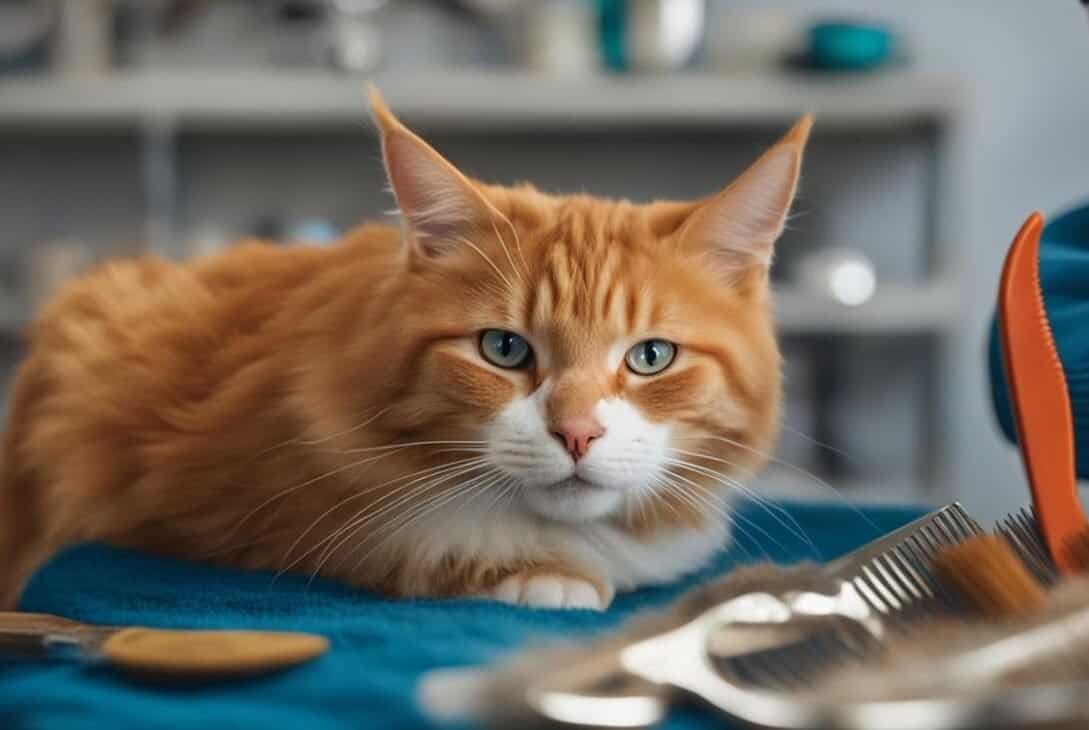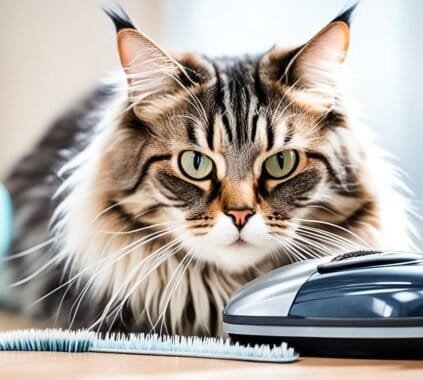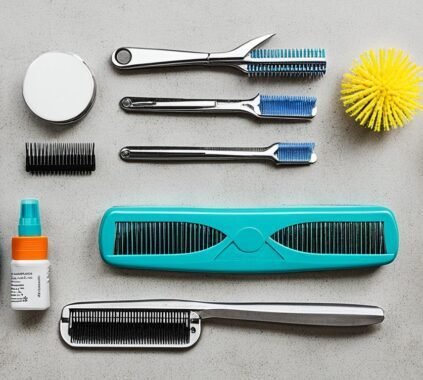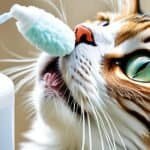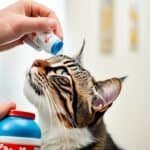Grooming is an important aspect of keeping your cat healthy and comfortable. Regular brushing and comb maintenance not only help to prevent matting and hairballs but also promote good skin health.
Whether you have a short-haired or long-haired cat, implementing a grooming routine is crucial for their overall well-being. In this article, we will provide you with cat brushing and comb maintenance techniques to effectively groom your cat and maintain their coat.
Key Takeaways:
- Grooming your cat regularly promotes healthy skin and prevents matting and hairballs.
- Choose the right brush and comb based on your cat’s fur type.
- Brush your cat gently and in the direction of hair growth to avoid discomfort.
- Use grooming sessions as an opportunity to bond with your cat and monitor their overall health.
- Seek professional grooming services if your cat requires specialized care or has difficulty tolerating grooming.
Skin and Fur Care
Bathing your cat is usually not necessary unless she gets dirty or smelly. However, when bathing is needed, following the right steps can ensure a stress-free experience for both you and your feline friend. Here are some tips for cat bathing and maintaining healthy skin and fur:
- Choose the right cat shampoo: Use a cat shampoo that is specially formulated for feline skin. Dilute the shampoo with water according to the manufacturer’s instructions.
- Gentle massage: Apply the diluted shampoo onto your cat’s fur and gently massage it in, taking care to avoid the face, ears, and eyes.
- Rinse thoroughly: After massaging the shampoo, rinse your cat thoroughly to remove all residue. Make sure there is no shampoo left on your cat’s fur.
- Drying: After the bath, dry your cat using a towel or a blow dryer on a low heat setting. Ensure that your cat is comfortable throughout the drying process.
Regular brushing is also essential for cat skin and fur care. It helps remove loose hair and prevent mats, especially for long-haired cats. Here are some grooming tools that can aid in maintaining a healthy coat:
- Metal comb: A metal comb is ideal for short-haired cats. It helps remove dirt, debris, and tangles from the fur.
- Wide-tooth comb: For long-haired cats, a wide-tooth comb is necessary to work out knots and prevent matting, especially in the legs, tummy, and tail.
By practicing regular bathing and brushing routines, you can help keep your cat’s skin clean and her fur healthy and shiny. Remember to consider your cat’s specific needs when selecting grooming tools and products. Prioritize her comfort and well-being throughout the grooming process.
Brushing Your Cat
Brushing your cat’s fur is an essential part of their grooming routine. Not only does it help to keep their coat clean and free from tangles, but it also provides several health benefits. Regular brushing sessions can stimulate blood circulation, improve the condition of their skin, and prevent hairballs.
Here are some cat brushing and combing techniques and tips to ensure that your furry friend’s coat stays healthy and beautiful:
Types of Cat Brushes
- Soft-Bristle Brush: This type of brush is ideal for removing loose hair and stimulating the natural oils in your cat’s skin. It is suitable for all cat breeds, especially those with short hair.
- Metal Comb: A metal comb is excellent for removing dirt and debris from your cat’s fur. It can also help with detangling and removing loose hair. This comb is suitable for both short-haired and long-haired cats.
- Wide-Tooth Comb: If your cat has long or thick fur, a wide-tooth comb is necessary to work out knots and prevent matting. It is particularly useful for grooming the legs, tummy, and tail.
Grooming Frequency
The frequency of cat grooming depends on the length and type of your cat’s coat. Short-haired cats typically require brushing once or twice a week to remove loose hair. Long-haired cats, on the other hand, may need daily brushing sessions to prevent mats and tangles.
Benefits of Cat Brushing and Comb Maintenance
- Removes Dirt and Dead Hair: Regular brushing helps to remove dirt, debris, and dead hair from your cat’s coat, keeping it clean and healthy.
- Stimulates Blood Circulation: Brushing stimulates blood circulation, which promotes a healthy and vibrant coat.
- Improves Skin Condition: Brushing removes excess oils and debris from your cat’s skin, improving its condition and reducing the risk of skin problems.
- Prevents Hairballs: By removing loose hair, brushing helps to prevent hairballs, which can be uncomfortable and potentially dangerous for your cat if ingested.
Remember, each cat is unique, and their grooming needs may vary. It’s important to observe your cat’s reactions during grooming sessions and adjust your techniques and frequency accordingly. By establishing a regular brushing routine and using the right tools, you can ensure that your cat’s coat remains beautiful and healthy.
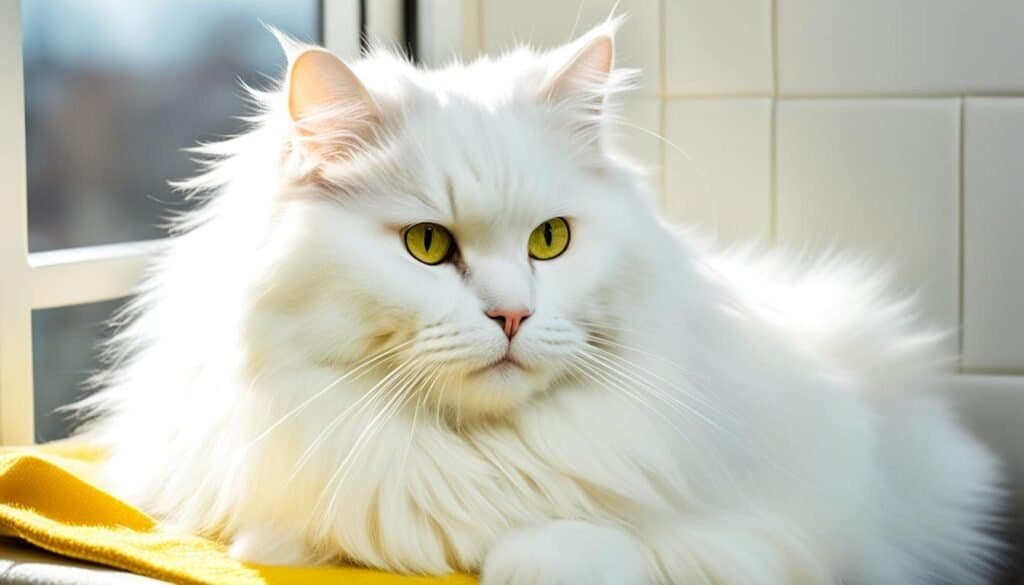
Skin Problems
Cats can experience various skin problems, including allergies, infections, and diseases. These conditions can cause discomfort and irritation to your feline friend.
It is important to be aware of the signs and symptoms of cat skin problems so that you can take appropriate action and seek veterinary care if necessary.
Some common symptoms of cat skin problems include:
- Itching: Cats may scratch or bite at their skin excessively, indicating irritation or discomfort.
- Redness: Inflamed or red patches on the skin may indicate an underlying issue.
- Hair loss: Bald patches or excessive shedding may be a sign of a skin problem.
- Scabs: Crusty or scaly areas on the skin can indicate an infection or other issue.
There are several potential causes of cat skin problems, including:
- Fleas: These parasites can cause itching, redness, and allergic reactions in cats.
- External Parasites: Mites, ticks, and other external parasites can irritate a cat’s skin.
- Seasonal Allergies: Cats, like humans, can be allergic to pollen, dust, and other environmental allergens.
- Bacterial or Yeast Infections: These infections can cause skin inflammation and irritation.
If you notice any abnormal skin conditions or symptoms in your cat, it is important to consult with a veterinarian. A proper diagnosis is crucial in addressing the underlying cause of the skin problem.

Preventing and Treating Skin Problems
To keep your cat’s skin healthy and free from problems, follow these cat skin care tips:
- Use hypoallergenic soaps and shampoos specifically formulated for cats. These products are gentle on their skin and reduce the risk of allergic reactions.
- Regularly brush your cat to prevent matting of the hair. This not only keeps their fur looking neat, but it also helps remove dirt and dead hair.
- Feed your cat a healthy diet that is free from fillers or artificial ingredients. A balanced diet can support their overall skin health.
- Implement a flea-treatment program recommended by your veterinarian. Fleas can cause skin irritations and allergies in cats, so prevention is key.
- Create a calm and stress-free living environment for your cat. Cats can develop skin problems due to stress or anxiety, so providing a peaceful atmosphere can help minimize skin issues.
If your cat already has skin problems, the appropriate cat skin treatment options may include:
- Topical products recommended by your veterinarian to alleviate specific skin conditions.
- A balanced diet tailored to address the underlying cause of the skin problem. Your vet can provide guidance on suitable dietary changes.
- Medications prescribed by your vet to treat bacterial or fungal infections that may be contributing to the skin problem.
- Dietary supplements that can promote healthy skin and reduce inflammation.
- In some cases, corticosteroids may be necessary to manage severe skin allergies or inflammations.
- A hypoallergenic diet designed for cats with allergies can help identify and eliminate potential allergens from their food.
Choosing the Right Cat Grooming Tools
Not all grooming tools are suitable for every cat. It’s important to select the right tools based on your cat’s fur type and grooming needs. Here are some essential cat grooming tools:
- Cat Brush: A cat brush is used to remove loose hair, tangles, and mats from your cat’s coat. For short-haired cats, a soft-bristle brush works well, while long-haired cats may require a brush with longer bristles to prevent matting. Regular brushing not only keeps your cat’s fur neat and tidy but also helps stimulate blood circulation and distribute natural oils.
- Cat Comb: A cat comb is designed to detangle and remove loose hair from your cat’s coat. For long-haired cats, a wide-tooth comb is essential to prevent matting, especially in areas like the legs, tummy, and tail. Short-haired cats can benefit from a metal comb to remove dirt and debris.
- Cat Nail Trimmers: Trimming your cat’s nails is an important aspect of grooming. Use specialized cat nail clippers to ensure a safe and precise cut. Be cautious of the quick, which is the sensitive part of the nail that can cause bleeding if cut too short. Regular nail trims help prevent your cat’s nails from becoming too long and causing discomfort or damage.
- Cat Grooming Scissors: While most grooming tasks can be done with brushes and combs, cat grooming scissors are handy for trimming any stray hairs or maintaining a specific hairstyle for certain cat breeds. It’s best to leave intricate and complex haircuts to professional groomers who have the necessary equipment and expertise.
By using the appropriate cat grooming tools, you can ensure that your cat’s grooming sessions are comfortable, efficient, and enjoyable for both you and your furry friend.
Tips for Home Cat Grooming
Establishing a regular cat grooming routine can help keep your furry friend looking and feeling their best. By taking care of basic grooming tasks at home, such as brushing, teeth brushing, nail trimming, and bathing when necessary, you can save money and strengthen the bond with your cat.
When it comes to grooming tools, you don’t need to break the bank. Look for gentle, safe options in the baby aisle of your local stores. These tools are designed to be soft and gentle, minimizing any potential discomfort for your cat during grooming sessions.
Start slow and allow your cat time to get used to the grooming process. Begin with short sessions, gradually increasing the duration as your cat becomes more comfortable. Remember to reward your feline friend with treats and praise to make the experience positive and enjoyable.
If your cat is not accustomed to grooming, be patient and understanding. Some cats may require more time and patience to become comfortable with the grooming routine. Take breaks as needed and always respect your cat’s boundaries.
By following these cat grooming tips and establishing a regular routine, you can help keep your cat clean, healthy, and happy.
Conclusion
Regular grooming is essential for maintaining the health and appearance of your cat. By following these cat grooming tips and tricks, you can ensure that your feline friend stays clean and comfortable.
Grooming not only removes dirt and dead hair but also helps prevent skin problems and stimulates blood circulation.
While some cats are comfortable with at-home grooming, others may require the expertise of professional cat grooming services for more specialized care. These professionals have the knowledge and tools to provide the best grooming experience for your cat.
Remember to tailor the grooming routine to your cat’s needs and preferences. Establish a grooming routine from a young age to make it a positive experience. Use appropriate grooming tools, such as cat brushes and combs, to effectively groom your cat’s fur. And don’t forget to reward your cat with treats and praise to create a positive association with grooming.
By prioritizing cat grooming and investing in professional cat grooming services when needed, you can ensure that your furry friend not only looks good but also enjoys the many benefits of a well-groomed coat.
Take the time to groom your cat regularly and enjoy the bond that it can create between you and your pet.
FAQ
Why is regular cat brushing and comb maintenance important for cats?
Should I bathe my cat?
How often should I brush my cat’s fur?
What are some common skin problems in cats?
How can I prevent skin problems in my cat?
What grooming tools are best for cats?
How can I groom my cat at home?
Why is professional grooming sometimes necessary for cats?
Last modified: February 26, 2024

